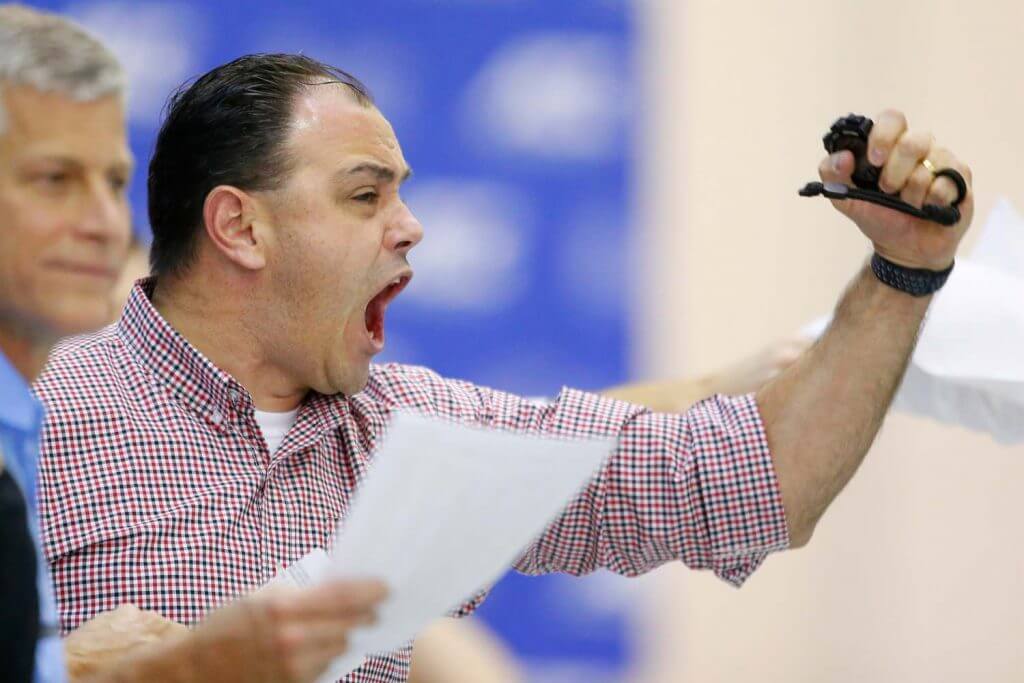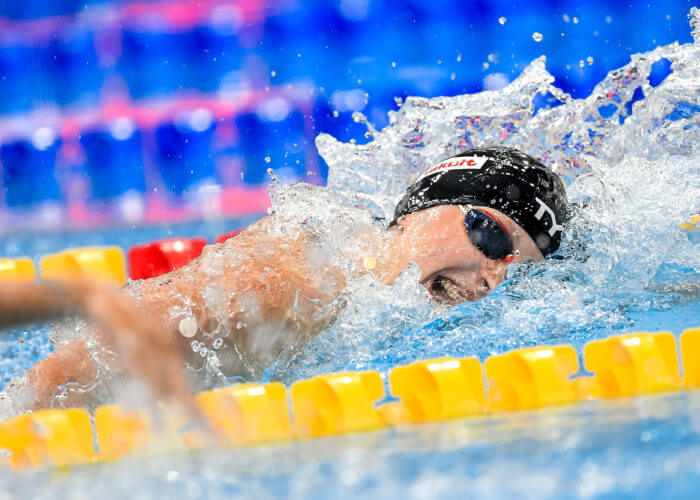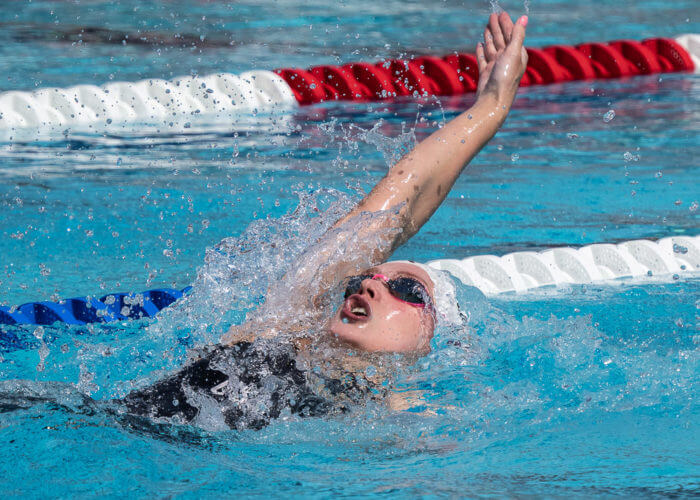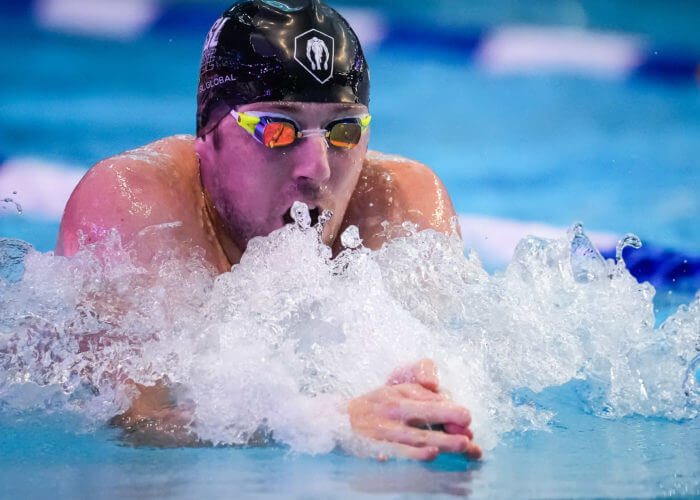5 Standard Cues To Promote Effective Coaching At Multiple Levels

5 Standard Cues To Promote Effective Coaching At Multiple Levels
In aquatics, whether it is teaching Learn to Swim or counseling higher-level athletes, there are many ways to teach technique. The use of five standard cues—visual, auditory, logical, verbal or kinesthetic—is a start.
Over the last 45 years, Coach Steve Haufler of the Orinda Country Club in Northern California has developed an instructional system dependent upon swimmer skill.
“When working with a beginning adult, I use pretty much the same progressions as I would for an 8-and-under. The vocabulary is different, but the approach in teaching strokes follows the same priorities: 1) air exchange, 2) body position and balance, 3) kicking, 4) pulling, 5) timing of kick and pull and 6) timing of the breath,” he says.
Essential to his approach is the use of simple cues—specific key words and phrases—by which he hopes the swimmer will sense what to feel, see or imagine. He utilizes a one-at-a-time progression for each stroke that has taught tens of thousands to swim. He tries to start instructions with a verb—i.e., using words and phrases such as see, feel and imagine, keep, stay, then, at the same time (to convey sequence), as soon as, before, after and instead of.
“Instructions don’t have to be precise—often, simpler is better. Stroke problems are frequently the effect of something that came before,” he says, “so go backward in time to see what is causing the problem. Teaching pressure, especially uninterrupted pressure (on the hands for instance), is crucial since that is how one achieves a feel for the water.
FREESTYLE BASICS
Virtually every coach—from Richard Quick with his “posture, line and balance” mantra to the present-day instructor—begins swim coaching by stressing body position. Haufler asks his beginners to lean their (air) lungs into the water, feel the legs float and imagine or feel their feet higher than their head. He encourages a neutral head position with a long neck (no wrinkles) and eyes looking down.

Photo Courtesy: Andrea Staccioli / Deepbluemedia / Insidefoto
Arms constitute about 85 percent of most freestyle propulsion. For entry, Haufler prefers it to be at shoulder-width, longest finger first with a high elbow. “Nothing behind the fingers goes in before them,” he says. When teaching a long and extended freestyle, he wants the swimmer’s palms facing the pool bottom on the extension of the arm. Then, try to imagine sliding “under the carpet” in a stretching, gliding and pausing motion. This lead hand will also remain in place while the other arm recovers and passes the head.
With the hand in the water, he looks for an easy press, fingertips down, palms facing back and an early vertical forearm. “Imagine wrapping your arm over a barrel before pulling. Begin the pull while keeping the elbow high. Complete the pull with a push back and letting the hand finish toward the outer edge of the thigh,” he says.
With the predominant bent-arm style, recovery requirements are a loose wrist, forward leading elbow and a relaxed palm that faces the body. A straight-arm recovery is shoulder-driven with an almost locked elbow that attacks the water from the top, while a hybrid recovery performs a rainbow arc, also swung from the shoulder. As for the kick, Haufler counsels constantly moving, loose legs that are kept in a “narrow, elongated box.” The energy should be generated from the top of the leg (not knees).
While coaches often first stress body position and pulling and kicking technique, most first-time swimmers are concerned with breathing. When teaching side breathing, Haufler uses a foam mannequin head to demonstrate a one-eye breathing technique. Once the swimmers are prone in the water, he asks them to imagine a pencil stuck in the top of their heads. He says, “Keep the pencil in the water when you turn your head to breathe.” This prevents the swimmer from lifting the top of the head when going to air.
He asks the swimmers to start the turn of the head as the lead arm enters the water. “With a gentle turn, keep one goggle in the water (‘one-eyed breathing’) and see the lane line next to you and inhale with the mouth close to the water. Then, return your face straight down and blow air out your nose gradually. The lead arm always remains forward of the head and keeps gliding forward while taking a breath.”
THE DORSAL STROKE
Some coaches start beginners with backstroke because it eliminates breathing problems. When kicking, the coach asks his swimmers to lean into the water with the upper back, pressing the ribs down and in (rather than up and out) and rolling the shoulders in. (Shaping like a canoe), keep the head still, ears in the water and imagine the head on a soft pillow with a cup of water on the forehead tipped slightly toward the chest—or really put one there!

Photo Courtesy: Peter H. Bick
On the recovery, the arms will exit the water from the thumb side of the hand, locking the elbows and lifting from the shoulder. “Let gravity shape your hand,” he says. Have the arms brush the ears as the arms roll in. The arms will attack the water with the little finger edge of the hand. On the pull, have the arm staying in the water only if it is doing work. Once in the water, move the arms like a scoop, an arm wrestle and then a throwing motion toward the feet, keeping the palms facing back. Like the freestyle, eliminate body resistance by slicing through the water (no barging) and kicking through a narrow tunnel.
Legs: Thanks to David Berkoff and others, the world’s best backstrokers are now excellent kickers. Haufler’s vocabulary with backstrokers is simple:
• Keep the legs long, ankles long and loose
• Finish the kick under water, keeping the knees in the water
• Kick water back, instead of up
• Press the bottom of the legs and feet down
• Imagine kicking your shoes off your feet, keeping the legs in a narrow box
• Bend the fins* both ways instead of pedaling the bike
• Keep the fins moving
(* Use of fins can markedly advance the backstroke learning curve)
BUTTERFLY
Preferred head position is neutral with eyes straight down. On the catch, let the hands press out very slightly before pressing palms back. Think vertical forearm while keeping elbows high. When breathing, vault forward over the hands with chin just skimming the water surface and imagine the head making a long skid mark on a very low ceiling. Pull with a slight light bulb motion and then flare out the arms away from the legs at exit. Recover with a flat low swing. Arms emerge out of the water away from the thighs with fingers pointed backward and little finger side up.
Keep the legs long without hammering the lower leg. Press toenails down, leaving them in the water while feeling both sides of the feet.
BREASTSTROKE

Photo Courtesy: Mike Lewis/ISL
Perhaps the toughest stroke to teach and toughest to master, swim instructors have a lot of moving parts to convey before they get a smooth performing breaststroker. Haufler starts with the kick, telling his swimmers to:
• Recover the lower leg behind the thighs while bringing the heels toward your bottom
• Keep the knees facing the bottom of the pool
• Flex the feet and turn them out
• Feel the toes spread apart as they curl back and separate
• Concentrate on moving the feet rather than the legs
• When kick fires, knees will be apart
• Kick back and together at the same time for a narrow kick that closes quickly
• Circle the lower leg back and around to full extension and squeeze
• Keep legs together when gliding
• Keep knees in the same place since the action takes place over the back of the legs—not under the stomach
When it comes to the arms, he asks that the swimmer:
• Imagine opening elevator doors
• Feel the shoulders come out of the ears
• Press to the tallest “Y” (the most forward “Y”)
• Imagine stretching a rubber band straight (thumb to thumb)
• Press out and maintain pressure on the water as hips move toward hands on the scoop
Regarding the catch, Haufler urges flexing the elbows (keeping them up) and position palms back and move to a vertical forearm. Then scoop the water “around the bowl” and “up the wall” as the thumb leads an upward scull toward the surface of the water. Shoot arms fast, straight, shallow and forward with thumbs slightly breaking the water.
While breathing, see the water close to the face and the hands flashing through the surface of the water. Breathe over upturned hands and turn the palms down as you extend. Take one second to breathe while leaning forward. Imagine a ponytail that stays on the back of the neck while sledding down the pool. “This prevents the lifting and tucking of the chin so common in beginning swimmers,” he says.
* * *
A recent internet check reveals there are 57,791 swim coaches in the United States. It is fair to say while there is a universal swim coach vocabulary, how those words are used and the actions that come as a result vary considerably based on the level of the swimmer. Nonetheless, adherence to the Haufler’s positive verb-oriented approach is a great way to introduce first timers to the wonderful water world that is, at its heart, a basic life skill.
Michael J. Stott is an ASCA Level 5 coach, golf and swimming writer. His critically acclaimed coming-of-age golf novel, “Too Much Loft,” is in its second printing, and is available from store.Bookbaby.com, Amazon, B&N and book distributors worldwide.
Non-Subscribers can click here to download this issue of Swimming World for only $5.94



